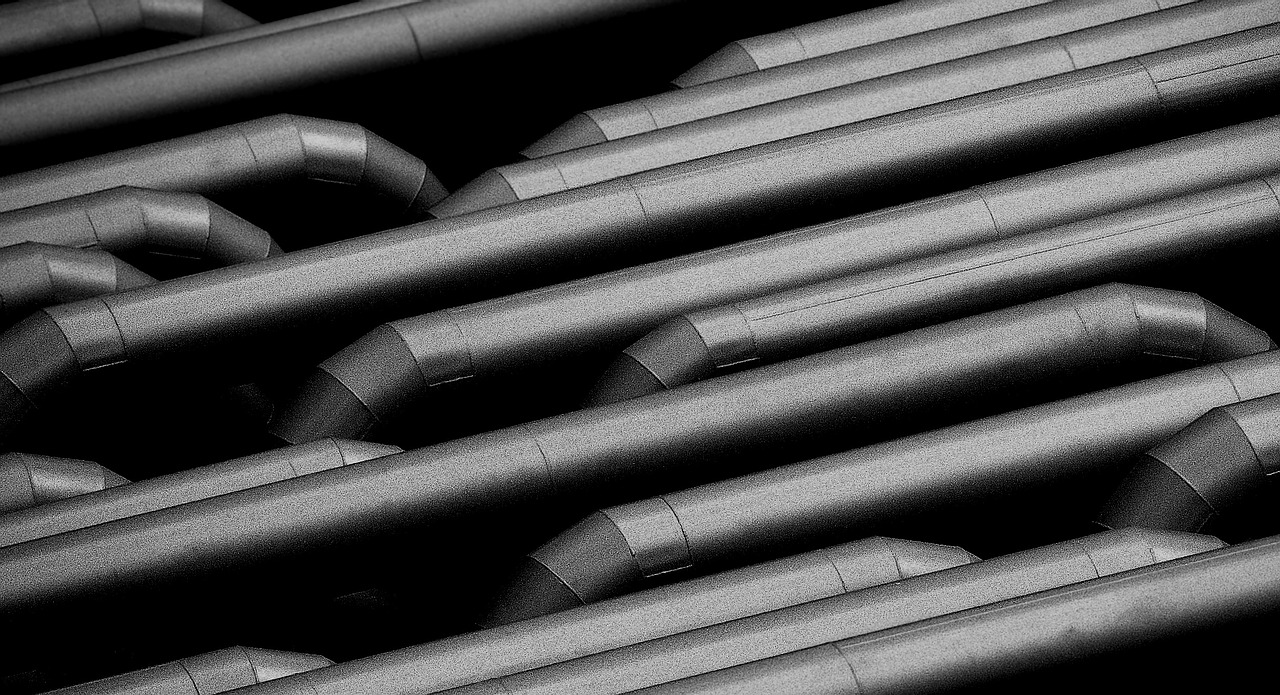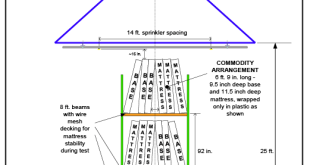
Omitting Flow From Sprinklers in the Design Area
Identifying Acceptable Small Compartments
One of the key aspects of designing a sprinkler system is making sure that the water supply can handle all of the sprinklers that are likely to open in a fire. There are at least three different ways to predict the number of sprinklers likely to open conservatively: using a specific number of sprinklers (as with ESFR, CMSA and residential sprinklers), assuming all of the sprinklers in the room will open (with the room design method), and selecting all of the sprinklers within a specific area (as with the density/area method). This article will focus on a specific aspect of the density/area method of hydraulic calculation and explain the one circumstance where you are permitted to drop the flow from a sprinkler out of your calculations, even when the sprinkler falls within the design area.
The specific section that we are dealing with is 23.4.4.7.2 in the 2016 edition of NFPA 13, Standard for the Installation of Sprinkler Systems, (similar sections appear in previous editions). The section specifically reads, “Where the design area is equal to or greater than the area in Table 23.4.4.7.2 for the hazard being protected by the sprinkler system, the discharge for sprinklers protecting small compartments 55 ft² (5.1 m²) or less, such as closets, washrooms, and similar compartments that are in the design area, shall be permitted to be omitted from the hydraulic calculations.”
This is certainly a mouthful. To fully understand the section, let’s break it down into smaller pieces and examine each piece closely. The first 24 words of the section deal with establishing the minimum size that the area needs to be in order to qualify for omitting the flow from certain sprinklers. A table is referenced with minimum size design areas for light, ordinary and extra hazard occupancies. These design areas correspond to the use of spray sprinklers without any decreases in design areas. So, if you were protecting a light hazard occupancy with a wet pipe sprinkler systems using quick response sprinklers and decreasing your design area below 1,500 ft², then you would not be permitted to use this section and you would need to include the flow from all of the sprinklers in the design area. Likewise, if you were protecting an extra hazard occupancy with a wet pipe system using high-temperature sprinklers and dropping your design area below 2,500 ft², then you would also not be able to use this section and you would need to flow water from all of the sprinklers in the design area.
Questions are frequently asked about why storage occupancies have been left out of the table. The answer is that the omission is intentional. The NFPA Sprinkler System Discharge Criteria Committee did not want people omitting the flow from sprinklers in storage occupancies. So, this section can only be used with light, ordinary and extra hazard situations.
The next part of the section talks about “the discharge for sprinklers protecting small compartments.” It is important to note that it is not the intent to use the “Small Room” definition of section 3.3.22 in this case. Even though the word “small” is used in section 23.4.4.7.2, there is no reason to apply the small room rule. The NFPA Committee has intentionally chosen the language “small compartments” to be different from “small rooms” so that the user does not connect these sections. Yet, so many people believe that there is a connection between these concepts, so it is important to spend a few words in this article making sure that people understand that the two ideas are independent.
In the next part of section 23.4.4.7.2, the concept of a small compartment is limited to 55 ft² or less. This is a new portion of the section, having been added in the 2016 edition. In previous editions, there was no specific size limitation in order to use this section, so sprinkler designers and Authorities Having Jurisdiction (AHJs) would frequently get into arguments about how “small” a compartment needed to be in order to use this section. For the 2016 edition, the NFPA Committee was asked to quantify how small a compartment needed to be. After considering “protected by a single sprinkler,” the Committee chose the more conservative 55 ft², because a single sprinkler can protect up to 400 ft² and the intent of this section is to only have it apply to much smaller spaces. The specific number of 55 ft² was chosen as a limit to correspond to two other places in NFPA 13 where the user is allowed to apply special rules: omitting sprinklers from dwelling unit bathrooms (8.15.8.1.1) and omitting sprinklers from small concealed spaces over small rooms (8.15.1.2.9). While there is nothing special about the number 55 ft², there was no reason to create a new arbitrary size for a special rule in a small compartment when there were already two rules at an already established arbitrary size.
Following the actual size limitation in this section are several examples of the kinds of compartments to which this section can be applied. These include, “bathrooms, closets, and similar compartments that are in the design area.” What does the NFPA Committee mean when it uses language like “similar compartments?” The answer, in this case, is that the compartment not only needs to be 55 ft² or less, but it also needs to be ancillary to the main use of the occupancy. Bathrooms and closets are examples of compartments that are not the main use of the building, but are there to support spaces used for some other main purpose. For example, in a business occupancy, the flow from a sprinkler in a small office, even if it was under 55 ft², would be required to be included in the design area.
This last concept is important because there is no limit to the number of times that this section can be applied in the same design area. If there are multiple closets and bathrooms that are all 55 ft² or less in area in the same design area, the flow from all of the sprinklers in all of these bathrooms can be omitted. In a business occupancy with lots of small offices, the NFPA Committee did not want the flow from the sprinklers in all of the offices to be omitted. If that happened, you might end up with a design area having no flow. Instead, the NFPA Committee wanted the use of this section to be limited to ancillary spaces that were not a part of the main use of the building.
Finally, this section wraps up with the payoff clause, which allows the flow to be omitted from the hydraulic calculations. What is important about the way that this section is written is that the flow is specifically omitted from the calculations, but the area is not. In other words, even though you don’t count the flow from the sprinkler in the bathroom or the closet while doing the calculations, you don’t take out the area of the compartment. The area still counts as satisfying the 1,500 ft² (or whatever area you need to meet Table 23.4.4.7.2).
Consider the portion of the office building shown in Figure 1 (where the doors have not been shown to simplify the drawing). The remote corner of the building has a few offices, a conference room, a few bathrooms and closets, a corridor and some open space for cubicles on the other side of the corridor. There are 19 sprinklers in the design area, which comprises a total of 1500 ft². Assuming the building is protected with a wet pipe sprinkler system as a light hazard occupancy, it would require quick response sprinklers. But perhaps because it has unsprinklered ceiling pockets, the design area has been selected to be 1500 ft². Under normal conditions, the flow from all 19 sprinklers shown in the shaded area of Figure 1 would need to be calculated. But in this case, section 23.4.4.7.2 allows the user to omit the flows from sprinklers 7, 8, 10, and 11 in the hydraulic calculations. Note that the flow from sprinkler 6 needs to be included in the calculations because this is an assistant’s office space and not an ancillary space like a bathroom or closet.
Even though the flows from sprinklers 7, 8, 10 and 11 are not included in the hydraulic calculations, the area of these rooms is still counted when trying to cover 1500 ft². The actual area covered by sprinklers 1, 2, 3, 4, 5, 6, 9, 12, 13, 14, 15, 16, 17, 18, and 19 comes to about 1475 ft², but it still counts as covering 1500 ft² because the area covered by sprinklers 7, 8, 10 and 11 are within the overall space protected by sprinklers.
The justification for this position is that the walls of the compartments in the small spaces, while not required to have any specific fire resistance rating, will delay or prevent the sprinklers from opening in these small spaces early in the fire scenario. With so many sprinklers calculated to size the water supply (15 in a light hazard occupancy) and so many compartment walls in the design area, the probability that any single fire will open all of these sprinklers is so small that it is reasonable to allow the flow from sprinklers 7, 8, 10, and 11 to be omitted from the calculations. Considering that an overwhelming majority of fires are controlled by four or fewer sprinklers in light hazard occupancies protected by wet pipe systems, a design that accounts for 14 sprinklers has plenty of safety factors built in and does not need to be increased to 19 just to prove that 1500 ft² of floor space is covered.
When the quick response reduction is used for the design area, the number of sprinklers that can be in the design area gets as low as five. In this case, the massive safety factors no longer apply, which is why the omission of the flow from sprinklers in small bathrooms and closets is not allowed to be applied when the quick response reduction is taken for the design area.
Although the discharge for these rooms is excluded from the calculation, they are still protected. As required by section 24.4.4.7.2.1, the individual sprinkler in each of these small compartments must be capable of discharging the density required for the hazard presented by the compartment. Hydraulically speaking, this will be easy to show since for a 55 ft² room, the density will likely exceed that required for an Extra Hazard Group 2 classification. Its main value is that it confirms that the fuel load is not restricted to a light hazard occupancy. Although it can be argued that the stated examples correlate with a light hazard occupancy based on washrooms, closets can contain significant fuel loads. As already stated (see Figure 1 on page 29), these small compartments are meant to be ancillary to the main use of that portion of the building.
 ABOUT THE AUTHOR: Since the fall of 2014, Kenneth E. Isman, P.E. has been a clinical professor in the fire protection engineering department at the University of Maryland. Prior to that, he worked for 28 years in the fire sprinkler industry. He has served as a representative on 19 different NFPA committees including one or more of the committees responsible for NFPA 13 or its predecessor storage protection standards since 1988. A noted author, Isman has written several books and contributed numerous chapters to NFPA and SFPE handbooks. His latest book, Standpipe Systems for Fire Protection, is available through Springer Publications
ABOUT THE AUTHOR: Since the fall of 2014, Kenneth E. Isman, P.E. has been a clinical professor in the fire protection engineering department at the University of Maryland. Prior to that, he worked for 28 years in the fire sprinkler industry. He has served as a representative on 19 different NFPA committees including one or more of the committees responsible for NFPA 13 or its predecessor storage protection standards since 1988. A noted author, Isman has written several books and contributed numerous chapters to NFPA and SFPE handbooks. His latest book, Standpipe Systems for Fire Protection, is available through Springer Publications
EDITOR’S NOTE: It should be noted that the above is the author’s opinion as a member of the NFPA Committee on Sprinkler System Discharge Criteria. It has not been processed as a formal interpretation in accordance with the NFPA Regulations Governing Committee Projects and should therefore not be considered, nor relied upon, as the official position of the NFPA or its committees.

 Sprinkler Age A Publication of the American Fire Sprinkler Association
Sprinkler Age A Publication of the American Fire Sprinkler Association



